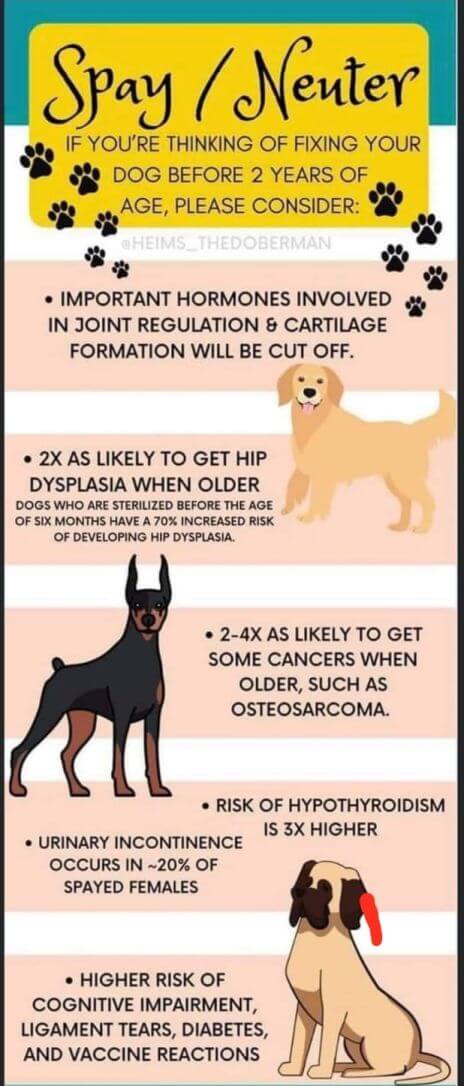Neutering or spaying the American Staffordshire terrier
A difficult choice?!
Spaying a bitch
If only this issue was so uncomplicated.
The basic principle that many vets use when spaying (castration) a bitch is to do this procedure before her first heat, there is an argument.
Except that the bitch in question, and the owner, due to the surgical removal of the ovaries (and sometimes the uterus), are not confronted with the inconveniences of the bitch coming into heat every 6 months, and that the phenomenon of false pregnancy after spaying no longer occurs, an early spayed bitch has less chance of mammary gland tumours and uterine inflammation.
So, let’s get her spayed?!
Disadvantages
Unfortunately, there are also some possible disadvantages to spaying:
- The risk of incontinence after the spaying procedure increases.
- In addition, bitches get more (undesired) undercoat (these are greasy and woolly short hairs, which lie directly against the skin).
- They often gain weight after sterilization.
- The insecurity of the bitch may increase after sterilization. This can also increase the risk of aggression.
It often happens that the young bitch does not develop further in terms of behaviour/character and can get stuck in the immature behaviour of a young dog. - Improved chance of the early onset of dementia.
- The benefit of reducing the risk of mammary tumours can also be seen as relative, because spaying increases the risk of other malignant tumours.
This is often “conveniently” not mentioned.

Mammary tumours
The genes also certainly play an important part that should not be underestimated in whether or not mammary tumours develop in our dogs.
In addition to the genes, we should not underestimate the nutritional influences either.
Nutrition (or the amount of food) can likewise influence the development of mammary tumours.
For example, obesity at a young age (1 year old) , or the consumption of foods with a high red meat content has been shown to promote these mammary tumours.
Mammary tumours mainly occur in the smaller dog breeds. These smaller breeds are seen as the highest risk group.
Having said that, there are several larger breeds that are at an increased risk.
For the time being, the American Staffordshire terrier is not referred to as an (increased) risk breed.
Cancer, the number 1 cause of death
Our practical experience has taught us that the chance that a bitch will have to deal with another type of cancer is relatively large.
Just like in us humans, the number 1 cause of death in dogs is as well cancer related.
Should a mammary tumour eventually develop in the bitch, there is a 50/50 chance that the mammary tumour will be malignant.
In other words, 50% of these tumours will not be immediately life-threatening. Of course, a benign tumour will need to be treated as well.
The importance of an annual (general) examination by your vet is clearly underlined here.
The doctor will carefully palpate the milk packets of the dog and examine whether there may be an unusual mass present.
Estrogen
Recent research has shown (School of Veterinary Medicine) that intact bitches that get mammary cancer have a better chance of survival than the the non-intact bitches. The estrogen, the hormone that is responsible for this form of cancer, has a more (positive) complex effect than just preventing, or not preventing mammary cancer.
Neutering a male
Neutering a male also raises the necessary issues.
Is it necessary at all?
What do you want to achieve with it?
What is the best time of neutering your dog?
Change in behaviour
The main reason indicated is often the annoying dominant behaviour. Is neutering then the right way to go?
Do the benefits of neutering outweigh its drawbacks (surgery, behaviour change)?
There is much to talk about.
Especially the clear change in character of a male after neutering is, for me personally, a reason to carefully consider neutering a male.
Fear agression
In most cases, aggression is indicated as one of the main reasons for resorting to neutering.
In my opinion we see a (negative) evolution in our beloved breed, we often see around us that aggression in the American Staffordshire terrier nowadays is a not self-confident form of aggression. In other words: A fear aggression.
When there is doubt whether we are dealing with this form of aggression, a dog behavioural therapist can be called in.
This fear aggression can actually be promoted by neutering.
In addition, I believe that our beloved breed is mentally a much more sensitive creature than, for example, a German Shepherd or a Doberman, which means that neutering can have an even greater negative influence with regard to the mental aspect of the dog.
He can become even more afraid or have even less self-confidence.
Other negative effects
In addition to the negative effects of neutering on behaviour, the slower metabolism and a negative effect on the coat condition, the bone decalcification that also occurs, I see males that are castrated often age faster.
In addition, there is apparently a higher risk of insulin resistance and diabetes, and a possible development of autoimmune diseases and allergies.
The relative increase in estrogen levels can also make the male look more feminine and the dog more susceptible to tumours.
As well there is increasing scientific evidence that neutering your dog increases the risk of prostate cancer.
Negative side effects for both males and females
For both males and females, after neutering or spaying at a young age, in addition to the aforementioned disadvantages, the following undesirable negative side effects can occur:
- The growth plates close with a delay, so that the dog gets longer and lighter bones. This increases the risk of skeletal and musculoskeletal disorders, such as HD/ED and ruptured cruciate ligaments.
- Osteoarthritis is more and more common in spayed/neutered dogs.
- In addition, you see that the development of the genitals and urinary tract is more often incomplete, which can lead to inflammation, among other things.
Influence of hormones
Medical science is constantly evolving and developing at a rapid pace. For example, I am convinced that in the future we will gain even more knowledge with regard to the (positive/negative) influence of sex hormones on the various complex processes in the animal body. Processes to which medical science currently don´t have an answer to or are not even aware of.
Homeopathy and/or chemical castration
Then we still have the option of using homeopathic medicines and the option of chemical castration.
Homeopathic medicines are remedies that contain extracts of various herbs.
If these substances ultimately prove to have insufficient effect and the dog owner nevertheless considers castration, then nowadays a subcutaneous hormone chip or implant can now be inserted as an alternative.
This procedure can usually be performed without anaesthetic and is similar to placing an identification microchip in a dog.
This chip inhibits the production of sex hormones in the testicles and in the ovaries. The substance is gradually released by the chip for at least half a year and in principle has about the same effect on the male as a physical castration.
The chip can be replaced several times and if eventually there is still an undesirable situation afterwards, you can always opt for a definitive sterilization or castration.
The false pregnancy
A reason to spay your dog?
False pregnancy in bitches – the phenomenon whereby non-pregnant bitches acquire physical and mental characteristics from a pregnant dog – is also a frequently mentioned motive for choosing sterilization.
Normally, bitches can handle the false pregnancy without that many problems, but there are also bitches who suffer a lot from these symptoms of the false pregnancy.
This both mentally as well as physically.
In response to this, medicines can then be used or one can also use the aforementioned homeopathic remedies (next to the regular medicines).
We ourselves try to work as little as possible with progestins. These drugs block the release of the sex hormones in the animal’s pituitary gland.
It has been shown that treatment with these kinds of medicines more than doubles the risk of mammal tumours in the future.
Our experience is that once a bitch has gone through a false pregnancy, there is a good chance that the false pregnancy will come back (and even more intense) after each subsequent heat. If the animal really starts to suffer too much from the physical symptoms and starts to show undesirable behaviour, then I see no other way out in this specific situation than to proceed with the actual sterilization.
Advice from your vet
With regard to neutering and spaying, I will always advise to follow the advice of your own vet.
This article is written and based on personal experiences, experiences of befriended kennel owners and doctors with whom we have worked together in the last 35 years. We certainly don’t have a monopoly on wisdom regarding this subject, but over the years, and because of all these experiences together we are very reluctant with our own bitches and males regarding spaying and neutering.
There is absolutely no standard advice.
The well-being of the dog comes first, and should always come first. In general, castration or sterilization, in our view, should only be considered when there is an indisputable medical reason.
